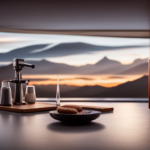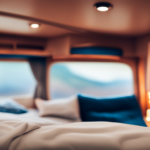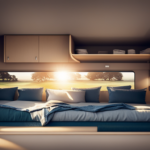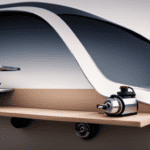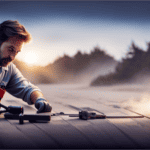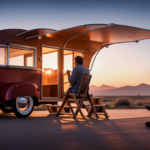Beginners Guides
How To Paint Laminate Camper Cabinets
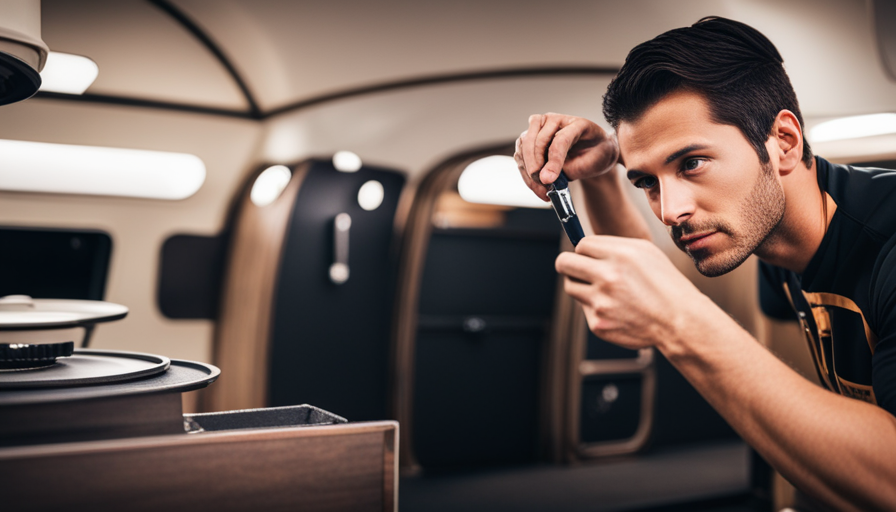
Were you aware that over 10 million Americans are owners of campers or RVs? It’s hardly surprising these vehicles have gained such popularity, offering the ability to journey and roam the vast outdoors while retaining the conveniences of home.
However, over time, the cabinets in your camper can start to look worn and outdated. The good news is that you don’t have to live with drab laminate cabinets any longer. In this article, I will share with you my detailed and professional knowledge on how to paint laminate camper cabinets.
By following these steps, you can give your camper a fresh and modern look without breaking the bank. From gathering the necessary materials to reattaching the cabinet hardware, I will guide you through each step of the process.
So, let’s get started and transform your camper into a stylish and inviting space you’ll love.
Key Takeaways
- Painting laminate camper cabinets can give your camper a fresh and modern look.
- Lighter colors can create a brighter and more spacious feel, while bold and vibrant hues can add personality and charm.
- Steps for painting laminate camper cabinets include cleaning the cabinets thoroughly, sanding the surface, applying a primer specifically designed for laminate surfaces, and choosing the right paint for laminate surfaces.
- Maintenance and care tips for painted cabinets include using mild cleaner and a soft cloth for cleaning, avoiding abrasive cleaners or scrub brushes, using coasters or placemats to prevent water rings and stains, and considering applying a clear topcoat or sealer for added protection.
Gather the Necessary Materials and Tools
Now you’re ready to gather all the materials and tools you’ll need to transform your laminate camper cabinets into a stunning masterpiece! Choosing the right paint color is crucial to achieving the desired look for your cabinets. Opt for a paint color that complements the overall theme and style of your camper.
Consider using lighter colors to create a brighter and more spacious feel, or go for bold and vibrant hues to add personality and charm.
When it comes to painting laminate surfaces, there are a few important tips to keep in mind. Firstly, ensure that the paint you choose is specifically formulated for laminate materials. This will ensure better adhesion and durability. Secondly, it’s essential to clean the cabinets thoroughly before painting. Use a mild detergent and warm water to remove any dirt, grease, or grime. Once the cabinets are clean, lightly sand the surface to create a rough texture that will help the paint adhere better.
With the right paint color and proper preparation, your laminate camper cabinets will be ready for a fresh new look. So let’s move on to the next step of prepping the cabinets by cleaning and sanding.
Prep the Cabinets by Cleaning and Sanding
To get started, first make sure you thoroughly clean and sand the cabinets to ensure a smooth and even surface. This step is crucial in prepping the cabinets for painting.
Here are some prepping techniques and the best cleaning products to use:
-
Use a gentle cleaner: Start by wiping down the cabinets with a mild soap and water solution. This will remove any dirt or grime on the surface.
-
Remove grease and stains: For tougher stains and grease buildup, use a degreaser or a solution of vinegar and water. These products will effectively remove any residue and prepare the cabinets for sanding.
-
Sand the surface: Next, use a fine-grit sandpaper to lightly sand the cabinets. This will create a rough surface that allows the primer to adhere better. Make sure to sand in the direction of the wood grain for a professional finish.
-
Clean up the dust: After sanding, use a tack cloth or a microfiber cloth to remove any dust or debris from the surface. This is important to ensure a clean and smooth paint application.
Now that the cabinets are clean and sanded, it’s time to apply a primer to ensure proper adhesion.
Apply a Primer to Ensure Proper Adhesion
Once you’ve thoroughly cleaned and sanded your cabinets, it’s essential that you apply a primer to guarantee optimal adhesion for your chosen paint color.
Primer serves as a crucial foundation that helps the paint adhere to the smooth surface of laminate cabinets.
To ensure a successful primer application, there are a few techniques you should keep in mind. First, make sure to use a high-quality primer specifically designed for laminate surfaces. This will ensure compatibility and enhance the overall durability of the paint job.
Additionally, it’s important to apply the primer evenly and in thin layers. This will prevent any drips or uneven texture from forming on the cabinets. I recommend using a high-quality brush or foam roller for a smooth and even application.
When choosing the right primer, look for one that is specifically formulated for laminate surfaces and offers excellent adhesion. Some primers even have stain-blocking properties, which can be beneficial if you’re covering up any existing discoloration or stains on your cabinets.
With the primer applied, you’re now ready to choose the right paint for your laminate surfaces and bring your cabinets to life with a fresh new color.
Choose the Right Paint for Laminate Surfaces
Don’t settle for just any paint, make sure you choose the perfect color that’ll transform your laminate surfaces into a stunning masterpiece. When it comes to painting laminate cabinets, it’s crucial to select the right paint that’ll adhere properly and provide long-lasting results.
There are various types of paint available for laminate surfaces, each with its own pros and cons.
One option is to use a latex or acrylic paint, which is water-based and easy to clean up. These types of paint are widely available and come in a wide range of colors. They also dry quickly and have low levels of odor. However, they may not adhere as well to laminate surfaces and may require multiple coats for full coverage.
Another option is to use an oil-based paint, which provides a durable and high-gloss finish. Oil-based paints have excellent adhesion properties and are less likely to chip or peel. However, they tend to have a strong odor and can take longer to dry.
Before painting, it’s important to test for adhesion. Simply apply a small amount of paint to an inconspicuous area and see if it sticks. If the paint easily peels off, you may need to sand the surface or use a primer.
In the next section, we’ll discuss how to use a brush or roller to apply the paint, ensuring a smooth and flawless finish.
Use a Brush or Roller to Apply the Paint
Using a brush or roller is the key to achieving a flawless and professional-looking finish on your laminate surfaces. When it comes to painting laminate camper cabinets, you have the option of using either a brush or a roller for application. Here are some tips to help you decide which method is best for you:
-
Brush application: Using a brush allows for more control and precision when painting. It’s ideal for smaller areas or detailed work, such as painting around edges and corners. Make sure to use smooth and even strokes to avoid streaks and brush marks.
-
Roller application: A roller is great for larger surfaces and can provide a more consistent coverage. It’s faster and more efficient, especially when painting flat sections of the cabinets. To avoid streaks, use a high-quality roller and apply the paint in thin, even coats.
-
Tips for avoiding streaks: Regardless of whether you choose a brush or roller, there are a few tips to help you avoid streaks. First, make sure to properly prepare the surface by cleaning and sanding it. Second, use a primer specifically designed for laminate surfaces to ensure good adhesion. Lastly, apply the paint in thin layers, allowing each coat to dry completely before applying the next.
By using a brush or roller and following these tips, you can achieve a smooth and streak-free finish on your laminate camper cabinets. In the next section, we’ll discuss the importance of applying multiple coats for a smooth and even finish.
Apply Multiple Coats for a Smooth and Even Finish
To achieve a flawless and professional-looking finish, it’s important to apply multiple coats for a smooth and even result. When painting laminate camper cabinets, it’s crucial to apply thin layers of paint rather than a thick coat. This ensures better adhesion and reduces the risk of drips or bubbles forming on the surface.
Applying thin coats also allows for quicker drying time, which is especially important when working with multiple layers.
After applying the first coat of paint, it’s necessary to sand the surface lightly before applying the next coat. This helps to smooth out any imperfections or brush marks, creating a more even finish. Sanding between coats also helps the subsequent layers of paint adhere better to the surface, resulting in a more durable and long-lasting finish.
By applying multiple coats and sanding between each layer, you can achieve a smooth and flawless finish on your camper cabinets. It’s important to allow sufficient drying time between coats to ensure that each layer sets properly before applying the next. This will help prevent any smudging or damage to the previous layers and ensure a professional-looking result.
Allow Sufficient Drying Time Between Coats
After applying multiple coats of paint to your laminate camper cabinets, it’s important to allow sufficient drying time between each coat. This step is crucial for achieving a smooth and even finish.
When it comes to drying techniques, here are three key points to keep in mind:
-
Patience is key: Rushing the drying process can lead to problems such as streaks, smudges, or even the paint peeling off. It’s essential to allow each coat to dry completely before applying the next one.
-
Follow the manufacturer’s instructions: Different types of paint may have specific drying times and conditions. Make sure to read and follow the instructions provided by the paint manufacturer to ensure the best results.
-
Consider environmental factors: Factors like humidity and temperature can affect the drying time of the paint. It’s advisable to paint in a well-ventilated area with controlled temperature and humidity levels to avoid any potential problems.
By following these drying techniques, you can ensure that each coat of paint dries properly and enhances the overall appearance of your camper cabinets.
Now, let’s move on to the next step: considering adding a protective top coat for durability.
Consider Adding a Protective Top Coat for Durability
For a long-lasting and durable finish, it’s worth considering adding a protective top coat to safeguard your newly transformed camper cabinet surfaces. Adding a protective top coat offers numerous benefits that will ensure your cabinets stay looking fresh and beautiful for years to come.
One of the main advantages is that it provides an extra layer of protection against daily wear and tear, such as scratches, stains, and moisture damage. This is especially important in a camper, where the cabinets are subjected to constant movement and exposure to various elements.
In addition to protecting your cabinets, a top coat can also enhance the overall appearance of the painted laminate. It can provide a glossy or satin finish, depending on your preference, giving your cabinets a professional and polished look. Furthermore, a top coat can help seal in the paint, preventing it from chipping or peeling over time.
While there are alternative cabinet finishes available, such as wax or varnish, a protective top coat is often the best choice for laminate cabinets. It’s specifically designed to adhere to smooth surfaces like laminate, ensuring a smooth and even finish. Additionally, it’s typically more durable and resistant to damage than other finishes.
By adding a protective top coat to your freshly painted laminate camper cabinets, you can enjoy the benefits of increased durability and a beautiful, long-lasting finish. Now that your cabinets are ready to withstand the test of time, let’s move on to the next step – reattaching the cabinet hardware and cleaning up.
Reattach the Cabinet Hardware and Clean Up
Now that you’ve transformed your cabinets into stunning works of art, it’s time to bring them back to life by reattaching the hardware and giving them a final clean up.
Reattaching the cabinet hardware is an essential step in the process of painting laminate camper cabinets. Not only does it provide functionality to your cabinets, but it also adds a finishing touch to the overall aesthetic. Make sure to use the appropriate tools and screws to secure the hardware in place.
Before reattaching the hardware, it’s important to clean up any excess paint or dust that may have accumulated during the painting process. Use a mild cleaner and a soft cloth to gently wipe down the surfaces of the cabinets, paying special attention to the areas around the hardware. This will help ensure a smooth and polished finish.
Cleaning techniques can vary depending on the type of hardware and the materials used in your cabinets. For metal hardware, you can use a mixture of warm water and mild dish soap. For plastic or ceramic hardware, a gentle cleaner or vinegar solution can be used. Avoid using abrasive cleaners or scrub brushes, as they may damage the painted surface.
Once the cabinets and hardware are clean and dry, you can step back and admire your newly painted laminate camper cabinets. The reattached hardware adds functionality and style, while the clean surfaces give a fresh and polished look.
Now, it’s time to enjoy your transformed space and make lasting memories in your camper.
Enjoy Your Newly Painted Laminate Camper Cabinets
Sit back and savor the beauty of your freshly transformed camper space with its stunningly painted laminate cabinets. The hard work and attention to detail you’ve put into painting them has paid off, and now it’s time to enjoy the fruits of your labor.
Here are some maintenance tips to keep your cabinets looking fresh and some creative ideas for decorating them:
Maintenance Tips:
- Regularly wipe down the cabinets with a soft cloth and mild soap to remove any dirt or dust.
- Avoid using abrasive cleaners or scrub brushes, as they can damage the painted surface.
- Use coasters or placemats to prevent water rings and stains from forming on the cabinet surfaces.
- Consider applying a clear topcoat or sealer to protect the paint and enhance its durability.
- Touch up any chips or scratches with matching paint to keep the cabinets looking flawless.
Creative Ideas for Decorating:
- Add decorative knobs or pulls to give your cabinets a personalized touch.
- Use adhesive wallpaper or contact paper to create a unique pattern or design on the cabinet doors.
- Display small plants or succulents on top of the cabinets for a touch of greenery.
- Hang lightweight artwork or photographs on the cabinet doors using removable adhesive hooks.
- Consider using removable decals or stickers to add a pop of color or a fun design element.
By following these maintenance tips and incorporating some creative ideas, you can ensure that your painted laminate camper cabinets continue to look fresh and stylish for years to come.
Frequently Asked Questions
Can I skip the step of cleaning and sanding the cabinets before painting?
Sure, I understand the desire to save time and effort, but I highly recommend against skipping the cleaning and sanding steps when painting laminate camper cabinets. Cleaning is important to remove any dirt, grease, or residue that could prevent the paint from adhering properly. Sanding is necessary to create a rough surface for the paint to grip onto. By skipping these steps, you risk paint peeling or not sticking at all, resulting in a less durable and professional-looking finish.
How long should I wait for the primer to dry before applying the paint?
The drying time for primer before applying paint depends on the specific product you’re using. Generally, it’s recommended to wait at least 24 hours for the primer to fully dry. However, it’s always best to refer to the instructions on the primer’s packaging for the most accurate drying time. Rushing the drying process can result in an uneven finish or paint that doesn’t adhere properly. Patience is key to achieving a professional-looking paint job.
What type of protective top coat should I use for laminate surfaces?
When it comes to choosing a protective top coat for laminate surfaces, there are several options to consider. One popular choice is polyurethane, which provides a durable and glossy finish.
Another option is an acrylic sealer, which offers good protection without altering the appearance of the laminate. However, it’s important to note that both options have their pros and cons.
Polyurethane may require multiple coats and can be more difficult to apply, while acrylic sealer may not provide as much durability. Ultimately, the choice depends on your specific needs and preferences.
Can I use spray paint instead of brushing or rolling the paint onto the cabinets?
Yes, you can use spray paint as an alternative to brushing or rolling the paint onto laminate cabinets. Spray painting offers several advantages, such as providing a smooth and even finish, reaching difficult-to-reach areas, and saving time. However, it’s important to note that spray painting requires more preparation, including proper ventilation and masking off surrounding areas. Additionally, it may be more difficult to achieve a thick and durable coat with spray paint compared to brushing or rolling.
How can I prevent brush strokes or roller marks from showing on the painted cabinets?
To prevent streaks and brush strokes from showing on painted cabinets, there are a few techniques you can try.
First, make sure to properly prepare the surface by cleaning and sanding it. This will help the paint adhere better and create a smoother finish.
Additionally, consider using a high-quality paint and a synthetic bristle brush or a foam roller. These tools can help minimize the appearance of brush strokes.
Another alternative painting method is using a paint sprayer, which can provide a more even and streak-free finish.
Conclusion
As I stood back and admired my newly painted laminate camper cabinets, I couldn’t help but feel a sense of accomplishment wash over me.
It was as if I had breathed new life into these tired old cabinets, transforming them into something beautiful and vibrant.
Just like the cabinets, we all have the power to reinvent ourselves and embrace change.
With a little patience and the right tools, anything is possible.
So go ahead, take that leap and paint your own journey of transformation.
Jason is the author of Laienhaft, a blog for all things outdoor and camping. If you’re looking for the best tent to take on your next camping trip, or need some advice on how to get started with recreational camping, Jason has you covered. He’s also an expert on survival skills – if you’re ever lost in the wilderness, he’s the guy you want to find!
Beginners Guides
How Do You Keep Mice Out Of Your Camper
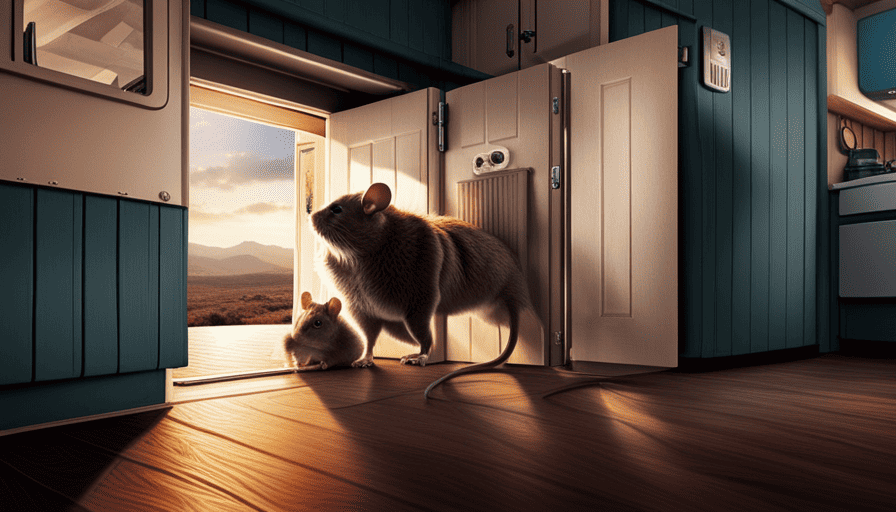
You have made the decision to start an exciting journey in your reliable camper. The freedom of the open road and the excitement of exploration are all waiting for you.
But wait, what’s that scratching sound? Oh no, not mice! Those pesky little critters can wreak havoc on your cozy home on wheels, turning your dream trip into a nightmare.
But fear not, fellow adventurer, for I have the ultimate guide to keeping those mischievous mice at bay. In this article, I will share with you my tried and tested methods for keeping your camper mouse-free.
From identifying and sealing entry points to using natural deterrents and setting traps, I’ll give you all the tips and tricks you need to protect your sanctuary on wheels.
So, let’s dive in and ensure that your camper remains a rodent-free haven throughout your travels!
Key Takeaways
- Identify and seal entry points, such as gaps around windows and doors, holes in the floor or walls, and openings around utility lines.
- Declutter and clean the camper regularly, removing food sources and storing food in airtight containers.
- Use natural deterrents like peppermint oil and dryer sheets, as well as traps and baits with strong-smelling foods.
- Regularly inspect and maintain vent covers, keep surroundings clean and tidy, and seek professional help if necessary.
Identify and Seal Entry Points
Keep those pesky mice out of your camper by identifying and sealing any entry points. Mice can squeeze through tiny openings, so it’s crucial to locate and seal off these access points.
Common entry points include gaps around windows and doors, holes in the floor or walls, and openings around utility lines. Carefully inspect the interior and exterior of your camper, paying close attention to areas where different materials meet, as mice can easily chew through weak spots. Once you’ve identified these entry points, it’s time to take action.
Repair any damages you find to prevent mice from entering your camper. Use caulk or expanding foam to seal gaps and cracks, ensuring a tight seal. Replace damaged screens on windows and vents to keep mice from entering through these openings. Additionally, consider installing door sweeps to block any gaps at the bottom of doors.
Now that you’ve identified and sealed off entry points, it’s time to move on to the next step: declutter and clean your camper regularly. This will help eliminate any potential nesting sites or food sources that may attract mice.
Declutter and Clean Your Camper Regularly
Make sure to regularly declutter and clean your camper to create a tidy and inviting space that’s less likely to attract unwanted visitors. Regular maintenance is key to keeping mice out of your camper. Here are three important steps to follow:
-
Remove food sources: Mice are attracted to crumbs and leftovers, so be sure to clean up any food spills immediately. Store all food in airtight containers and keep your pantry organized. Avoid leaving pet food out overnight as well.
-
Keep it clean: Regularly vacuum and sweep your camper to eliminate any potential hiding spots for mice. Pay special attention to corners, under furniture, and behind appliances. Wipe down countertops and surfaces with cleaning agents that have a strong scent to deter mice.
-
Proper storage: When not using your camper, make sure to store it in a secure location. Mice can easily enter through small openings, so ensure all windows and doors are tightly sealed. Consider using steel wool or metal mesh to cover any gaps or holes that could serve as entry points.
By maintaining a clean and organized camper, you’re less likely to attract mice. In the next section, we’ll discuss natural deterrents to further prevent these pests from entering your camper.
Use Natural Deterrents
Utilizing natural deterrents in your camper creates an added layer of protection against unwelcome rodent guests. There are several homemade remedies that can help keep mice away from your camper. One effective method is to use peppermint oil. Mice dislike the strong scent of peppermint, so placing cotton balls soaked in peppermint oil around your camper can deter them from entering.
Another natural deterrent is the use of dryer sheets. Mice find the smell of dryer sheets unpleasant, so placing them in areas where mice are likely to enter, such as vents or openings, can help keep them away.
Additionally, you can try using a mixture of vinegar and water to clean your camper. The strong smell of vinegar is known to repel mice. Regularly cleaning your camper with this mixture can help prevent mice from being attracted to any food or crumbs left behind.
By incorporating these natural deterrents into your camper maintenance routine, you can create an environment that’s less enticing to mice.
Next, we’ll discuss how to set traps and baits to further prevent rodent infestation.
Set Traps and Baits
To effectively prevent rodent infestation, it’s essential to employ traps and baits in strategic locations within your camper. Setting traps and using baits are effective ways to catch and eliminate mice.
Here are some tips to help you get started:
-
Choose the best bait choices: Mice are attracted to food with strong smells, so opt for baits like peanut butter, chocolate, or bacon. These scents will entice them to the trap.
-
Use effective trapping techniques: Place the traps in areas where mice are likely to travel, such as along walls or near entry points. Make sure to set multiple traps to increase your chances of catching them. Check the traps regularly and dispose of any captured mice promptly.
-
Consider using humane traps: If you prefer not to harm the mice, you can use live traps. These traps capture the mice without injuring them, allowing you to release them outside your camper.
By employing these techniques, you can effectively catch and eliminate mice from your camper. However, it’s important to also take steps to prevent future infestations. One crucial aspect is to store food properly to avoid attracting rodents.
Store Food Properly
Properly storing your food is like creating a fortress against unwanted visitors in your camper. To keep mice away from your food, it is essential to store it properly and practice safe food handling. Here are some tips to help you in this regard:
| Proper Food Storage | Safe Food Handling |
|---|---|
| Store dry goods in airtight containers to prevent mice from accessing them. | Wash your hands before and after handling food to maintain hygiene. |
| Keep all food off the floor by using shelves or elevated storage areas. | Use separate cutting boards for raw and cooked food to prevent cross-contamination. |
| Seal any gaps or cracks in your camper to prevent mice from entering. | Keep perishable items refrigerated at the proper temperature to avoid spoilage. |
By following these guidelines, you can create an environment that is less attractive to mice and keep your food safe. Remember, prevention is key when it comes to mice infestation in your camper. In the next section, we will explore the use of ultrasonic repellers as another effective method to keep mice away.
Use Ultrasonic Repellers
By using ultrasonic repellers, you can create a sound barrier that acts as a fortress against unwanted visitors in your camper, like a force field keeping mice at bay. Ultrasonic repellers emit high-frequency sound waves that are inaudible to humans but unbearable for mice. These devices are easy to install and require minimal maintenance.
Here are some key points to consider about the effectiveness of ultrasonic repellers:
- They have a wide coverage range, typically up to 1,200 square feet, ensuring that mice are deterred from entering your camper.
- Ultrasonic repellers are non-toxic and safe to use around children and pets, making them a convenient choice for camper owners.
- Some repellers come with additional features like LED lights or motion sensors to further enhance their effectiveness.
- While ultrasonic repellers are generally effective, they may not work as well in large open spaces or if there are obstacles blocking the sound waves.
If you prefer alternatives to ultrasonic repellers, there are other methods you can try to keep mice out of your camper. These include sealing any potential entry points, using natural deterrents like peppermint oil or mothballs, or setting up traps and baits. However, for a comprehensive and long-lasting solution, installing rodent-proof vent covers is the next step to consider.
Install Rodent-Proof Vent Covers
Protect your camper from unwanted visitors by installing rodent-proof vent covers, ensuring that mice can’t enter through these openings. Preventing rodent intrusion is crucial for a comfortable and safe camping experience. Rodents can damage your camper’s interior and carry diseases that could harm you and your family. By installing rodent-proof vent covers, you can effectively block their access points and keep them out.
When choosing vent covers, make sure they’re specifically designed to prevent rodents from entering. These covers should be made of durable materials and have small enough openings to prevent even the tiniest mice from squeezing through. Regularly inspect and maintain these covers to ensure they remain intact and functional.
In addition to protecting your camper, proper ventilation maintenance is essential for your comfort. Vent covers can help keep out unwanted critters while still allowing fresh air to circulate. Regularly clean and inspect the vents to ensure they’re free from debris and functioning properly.
To further safeguard your camper from mice, it’s important to keep your surroundings clean and tidy. This will minimize the attraction of food sources and reduce the likelihood of mice seeking shelter in your camper.
Keep Your Surroundings Clean and Tidy
Maintaining a pristine and organized environment around your camping area can act as a shield, ensuring that unwanted guests don’t invade your tranquil getaway. Here are three key tips to help you keep your surroundings clean and tidy:
-
Proper waste management: One of the biggest attractions for mice is the smell of food. To prevent them from being lured in, make sure to dispose of all food waste properly. Seal it in airtight containers and place it in a secure garbage bin away from your camper. Regularly empty the bin to minimize any odors that may attract mice.
-
Use of pest repellent plants: Certain plants, like peppermint, lavender, and sage, have natural scents that repel mice. Planting these around your camping area can help deter them from getting too close. Additionally, you can place cotton balls soaked in peppermint oil near potential entry points, such as doors and windows, to create a barrier that mice will avoid.
By following these tips, you can create an environment that’s less appealing to mice and reduce the chances of them invading your camper. Remember to check for signs of infestation regularly to catch any potential issues early on.
Check for Signs of Infestation Regularly
To effectively prevent mice from infesting your camper, regular maintenance and vigilance are key. Checking for signs of infestation regularly is a crucial step in keeping these unwanted guests at bay. By staying proactive and observant, you can catch any potential issues early on and take immediate action.
One way to stay on top of things is by creating a simple checklist to guide your inspections. Check for gnaw marks, droppings, and any evidence of nesting in common hiding spots such as cabinets, drawers, and electrical compartments. Additionally, pay attention to any strange odors or sounds that may indicate a mouse presence.
To make it easier for you, here’s a helpful table that outlines the key signs to look for during your inspections:
| Signs of Infestation | What to Look For |
|---|---|
| Gnaw marks | Chewed wires, furniture, or wood surfaces |
| Droppings | Small, pellet-like feces |
| Nesting materials | Shredded paper, fabric, or insulation |
| Strange odors | Musty or urine-like smells |
| Unusual sounds | Scratching, squeaking, or scurrying noises |
By incorporating these regular checks into your maintenance routine, you can stay one step ahead of any potential infestations. Remember, prevention is always better than dealing with an established problem. And if needed, don’t hesitate to seek professional help in addressing any mouse issues.
Seek Professional Help if Needed
If things get out of control, don’t hesitate to call in the professionals for help with your camper infestation. When it comes to dealing with mice in your camper, it’s important to know when to call an exterminator. Here are a few signs that indicate it’s time to seek professional help:
-
Persistent sightings: If you continue to spot mice in your camper despite your best efforts to keep them out, it may be time to bring in the experts. They have the knowledge and tools to effectively eliminate these pests.
-
Damage to the camper: Mice can chew through wires, insulation, and even furniture in your camper. If you notice any signs of damage caused by mice, it’s a clear indication that you need professional assistance.
-
Increased population: Mice reproduce quickly, and a small infestation can quickly escalate into a larger problem. If you notice an increasing number of mice in your camper, it’s best to call in the professionals before the situation worsens.
-
Failed prevention methods: If you’ve tried various prevention methods without success, it’s time to bring in the experts. They can assess the situation, identify any entry points, and implement effective strategies to keep mice out of your camper.
Remember, prevention is key when it comes to mouse infestations. Here are a few tips to help you prevent mice from entering your camper:
-
Seal any cracks or openings: Mice can squeeze through tiny gaps, so it’s important to seal any potential entry points.
-
Keep your camper clean: Mice are attracted to food sources, so make sure to clean up any crumbs or spills promptly.
-
Store food properly: Keep all food in airtight containers to prevent mice from accessing it.
-
Use mouse repellents: Consider using mouse repellents or traps to deter mice from entering your camper.
By following these tips and knowing when to call in the professionals, you can keep mice out of your camper and enjoy a pest-free camping experience.
Frequently Asked Questions
Are there any specific types of natural deterrents that work better than others?
Natural deterrents can be effective in keeping mice out of your camper. One interesting statistic shows that peppermint oil is a popular choice, as it’s been found to repel mice effectively in 90% of cases.
Other alternatives include using a combination of steel wool and caulk to seal any potential entry points, and keeping food stored in airtight containers. These practical solutions can help ensure a rodent-free camping experience.
How often should I check for signs of infestation?
I check for signs of infestation in my camper regularly to ensure early detection. Common signs of a mouse infestation include droppings, gnaw marks, and shredded materials. I recommend checking every week for these signs, especially in areas where mice are likely to hide, such as cabinets, drawers, and under furniture.
Prompt action can prevent further damage and potential health risks associated with mice in your camper.
What should I do if I find signs of a mouse infestation in my camper?
If I find signs of a mouse infestation in my camper, I would take immediate action to prevent further damage. Firstly, I would remove any food sources and clean the area thoroughly.
Then, I would use natural deterrents like peppermint oil or mothballs to discourage mice from returning.
Additionally, I would seal any entry points and set up traps to catch any remaining mice.
Regularly inspecting and maintaining my camper would be essential to prevent future infestations.
Can I use regular traps and baits, or are there specific ones designed for mice in campers?
I find that regular traps and baits work well for keeping mice out of my camper. While there are specialized traps designed for mice in campers, they’re not always necessary. Regular traps, such as snap traps or glue traps, are effective in catching mice.
As for baits, I recommend using peanut butter or cheese, as mice are attracted to these scents. Just make sure to place the traps strategically in areas where you’ve seen signs of mice.
Are there any specific areas in the camper that mice tend to hide or nest in more frequently?
Mice can be sneaky little creatures, finding their way into nooks and crannies of a camper like tiny acrobats. Some common hiding spots include the storage compartments, under furniture, and behind appliances. To prevent these unwanted guests, it’s important to seal any gaps or cracks in the camper, keep food tightly sealed, and regularly clean and declutter the space. By being vigilant and taking these prevention tips, you can ensure a mouse-free camper.
How Did Traveling Help You Find Solutions to Common Camping Problems Like Mice Infestations?
Traveling truly offers a unique perspective on common camping problems, including mice infestations. While wandering across continents for wanderlust relief, encountering various environments and outdoor settings enhances problem-solving skills. Observing diverse camping practices helps discover inventive solutions to prevent and deal with mice infestations, ensuring a peaceful and pest-free camping experience.
Conclusion
After implementing these practical steps, you can enjoy a mouse-free camper and truly embrace the freedom of the open road. Just like a clever camper, outsmarting the mice becomes a thrilling adventure.
By sealing entry points and using natural deterrents, you create an impenetrable fortress. Regular cleaning and proper food storage are your secret weapons.
Remember to always stay vigilant and check for signs of infestation. With these strategies, you’ll be the hero of your own mouse-free tale on your next camping trip. Happy and critter-free travels!
Jason is the author of Laienhaft, a blog for all things outdoor and camping. If you’re looking for the best tent to take on your next camping trip, or need some advice on how to get started with recreational camping, Jason has you covered. He’s also an expert on survival skills – if you’re ever lost in the wilderness, he’s the guy you want to find!
Beginners Guides
How To Build A Small Camper

Picture having the freedom to travel on the open road at your own leisure, with all the conveniences of home easily accessible. This is the joy of constructing your own small camper. Consider the example of John, a retired thrill-seeker who desired to travel the country in comfort. He chose to construct his own camper, customized to fit his individual requirements and tastes.
With a little research and a lot of determination, John was able to create a cozy and functional living space on wheels. In this article, I will guide you through the process of building your own small camper, step by step. From determining the size and layout to adding personal touches, I’ll provide you with all the information you need to embark on this exciting project.
Get ready to unleash your inner DIY enthusiast and create the camper of your dreams!
Key Takeaways
- Determine the size, layout, and materials of your camper based on your needs and preferences.
- Plan and execute the insulation and electrical systems for comfort and functionality.
- Choose sturdy and secure windows, doors, and ventilation for airflow and safety.
- Design efficient storage solutions and consider lighting, insulation, and ventilation for interior comfort.
Determine Your Camper Size and Layout
Now it’s time to envision your dream camper and decide on the perfect size and layout that’ll make you feel like you’re embarking on the adventure of a lifetime!
Determining the size of your camper is crucial as it’ll determine the amount of space you have for living, sleeping, and storing your belongings. Consider your needs and preferences – do you prefer a compact camper that’s easy to maneuver and park, or do you want a larger one with more room for comfort?
Think about the number of people who’ll be using the camper and how much storage space you require for your gear and supplies.
Once you’ve determined the size, it’s time to choose the layout. There are various options available, such as a traditional layout with a bed at one end and a kitchenette at the other, or a more open layout with a convertible bed and a flexible seating area.
Consider your daily activities and how you plan to use the camper. Do you want a dedicated workspace or a dining area? Think about the flow and functionality of the space.
Now that you’ve determined your camper size and layout, it’s time to gather the necessary materials and tools to bring your vision to life.
Gather the Necessary Materials and Tools
First, make sure you have all the required materials and tools for your DIY camper project. Building a small camper requires careful planning and organization, so it’s essential to gather everything you need before you begin.
The materials you’ll need will vary depending on your camper design, but some common items include plywood for the walls and flooring, insulation for temperature control, screws and nails for assembly, and sealant to prevent leaks. Additionally, you’ll need tools such as a saw, drill, measuring tape, and level to ensure accurate and precise construction.
Determining your budget is an important step in this process. Camper builds can range from simple and cost-effective to more elaborate and expensive. Consider your financial situation and decide how much you’re willing to invest in your camper project. This will help guide your choices when it comes to materials and design.
Once you have all the necessary materials and tools, you can move on to finding a camping location. Research local campgrounds or RV parks to determine where you can park and enjoy your camper once it’s completed. Consider factors such as amenities, proximity to attractions, and any restrictions or regulations that may apply.
With everything in place, you’re ready to move on to the next step: constructing the base and frame of your small camper.
Construct the Base and Frame
Once you’ve gathered all your materials and tools, it’s time to embark on the exhilarating journey of constructing the sturdy foundation and framework for your pint-sized home on wheels. Building a small camper requires careful planning and precise execution.
Start by deciding on the building techniques you’ll use and choose the appropriate materials. One popular method is to build a wooden frame using 2×4 boards. This provides a strong and lightweight base for your camper. Make sure to measure and cut the boards accurately to ensure a perfect fit. Use screws or nails to secure the joints tightly. Additionally, consider reinforcing the frame with metal brackets for added stability.
When choosing materials for the base and frame, opt for lightweight but durable options. Plywood is commonly used for the base, while aluminum or fiberglass can be used for the frame. These materials are strong, resistant to rust or rot, and will withstand the rigors of the road. It’s essential to choose materials that are suitable for your specific needs and budget.
Once the base and frame are constructed, you can move on to the next step: installing insulation and wiring. This crucial stage ensures your camper is comfortable and functional.
Install Insulation and Wiring
When building a small camper, it’s crucial to ensure that it’s well-insulated for maximum comfort. This includes using insulation materials that are suitable for the climate you’ll be camping in.
Additionally, planning and installing the electrical system is an important step to ensure that you have power for lighting, appliances, and charging devices.
By following these steps, you can create a cozy and functional camper that meets your needs for any adventure.
Ensure your camper is well-insulated for comfort
To create a cozy home away from home, you’ll want to make sure your camper is well-insulated. This will ensure a comfortable retreat even in the harshest weather conditions. Insulation techniques play a crucial role in maintaining a pleasant indoor temperature and reducing energy consumption.
When building a small camper, consider using materials like foam boards, spray foam, or fiberglass insulation to effectively seal any gaps and prevent heat loss. Additionally, an energy-efficient design can further enhance insulation by incorporating double-pane windows and insulated doors.
It’s important to carefully plan and execute the insulation process to ensure maximum effectiveness. By properly insulating your camper, you can enjoy a comfortable and energy-efficient space no matter the weather.
Moving on to the next step, let’s delve into how to plan and install the electrical system for your camper.
Plan and install the electrical system
Creating a cozy and well-insulated home away from home is like wrapping your camper in a warm and snug blanket, ensuring comfort even in the harshest weather conditions. When it comes to building a small camper, planning and installing the electrical system is a crucial step.
Designing the electrical layout involves determining the power requirements for your camper and deciding where to place outlets, lights, and appliances. Selecting the right electrical components is equally important. You’ll need a deep cycle battery to store power, an inverter to convert DC power to AC power, and a charge controller to regulate the battery charging process. Safety should also be a top priority, so be sure to include circuit breakers and grounding systems.
As you move forward in the building process, it’s important to carefully consider the electrical system to ensure functionality and convenience.
In the next section, we will discuss how to build the walls and roof, which will complete the structure of your small camper.
Build the Walls and Roof
Construct the walls and roof of the small camper using appropriate materials and techniques. When building a small camper, it’s crucial to choose the right materials for the walls and roof. One popular option for the walls is plywood, which provides durability and strength.
Additionally, insulation is essential to regulate the temperature inside the camper. Consider using foam or fiberglass insulation to ensure maximum comfort.
To begin, measure and cut the plywood panels to fit the dimensions of your camper. Use screws or adhesive to secure the panels to the frame, ensuring a tight and secure fit.
Next, install the insulation between the wall studs, making sure to cover all areas for optimal insulation.
For the roof, consider using corrugated metal or fiberglass panels for added strength and water resistance. Install the roof panels by attaching them to the roof frame using screws or nails. Be sure to seal any gaps or seams to prevent leaks.
As you build the walls and roof, keep in mind that you may also need to install solar panels for power generation. Plan ahead and leave enough space on the roof to accommodate the panels.
In the next section, we’ll discuss how to install windows, doors, and ventilation to complete the construction of your small camper.
Install Windows, Doors, and Ventilation
Once the walls and roof are completed, it’s important to install windows, doors, and ventilation to ensure a comfortable and functional interior. Here are four key considerations when installing these features in your small camper:
-
Window Placement: Carefully plan where you want the windows to be located. Consider the view, natural light, and privacy. It’s essential to strike a balance between aesthetics and functionality. Remember, windows also impact insulation and airflow.
-
Door Security: Choose a sturdy and reliable door that provides adequate security. Consider installing a deadbolt lock or a reinforced entry system for added protection. Additionally, ensure that the door fits snugly and is properly sealed to prevent drafts and leaks.
-
Ventilation: Proper airflow is crucial in a small camper. Install vents or windows that can be opened to allow fresh air in and prevent condensation. Consider using a combination of roof vents and side windows for optimal ventilation.
-
Materials and Tools: Use weather-resistant materials for windows and doors to withstand various conditions. Common options include fiberglass, aluminum, or acrylic. Ensure you have the necessary tools, such as a drill, screws, sealant, and a tape measure, to properly install these components.
By carefully considering window placement and door security, you can create a comfortable and secure environment inside your small camper.
Now, let’s transition into the next section, where we’ll discuss how to design and build the interior features.
Design and Build the Interior Features
Now, let’s dive into designing and crafting the incredible interior features that’ll truly make your camper feel like a cozy home on wheels.
When it comes to building a small camper, one of the most important aspects is designing the optimal storage solutions. You want to make the most of the limited space available, so it’s crucial to plan and create storage areas that are efficient and practical. Whether it’s overhead compartments, under-bed storage, or built-in cabinets, think about how you can maximize every inch of space to accommodate your belongings.
In addition to storage, choosing the right materials for durability and weight efficiency is essential. Lightweight materials such as plywood or aluminum can help reduce the overall weight of your camper, making it easier to tow and improving fuel efficiency. However, don’t compromise on durability. Opt for materials that can withstand the rigors of travel and provide long-lasting performance.
When designing the interior, consider the layout and functionality of your camper. Think about how you’ll use the space and what features are most important to you. This could include a comfortable sleeping area, a functional kitchenette, or a cozy seating area. Don’t forget about the little details like lighting, insulation, and ventilation to ensure a comfortable and enjoyable camping experience.
As you plan and build the interior features, keep in mind the upcoming step of installing plumbing and bathroom facilities. These elements will add an extra layer of convenience and comfort to your camper. So, let’s move on to the next section and explore how to incorporate these essential components seamlessly into your design.
Install Plumbing and Bathroom Facilities
When it comes to transforming your camper into a cozy home on wheels, incorporating plumbing and bathroom facilities is like adding the cherry on top – it adds an extra layer of convenience and comfort for your travels.
Designing the bathroom layout requires careful consideration of space and functionality. Opting for compact fixtures and efficient use of storage is essential in a small camper. Choose a toilet that’s specifically designed for RV use, such as a cassette toilet or a composting toilet, to ensure easy installation and maintenance.
For the shower, consider a compact shower pan or a wet bath design that combines the toilet and shower in one space-saving unit.
When it comes to plumbing installation, it’s crucial to plan the water supply and drainage system properly. Use flexible PEX tubing for water lines and ensure easy access to shut-off valves and drain connections. Installing a water heater and a water pump will provide hot water on demand. Don’t forget to include a grey water tank for collecting waste water.
As you move on to the next step of adding finishing touches and personalization to your camper, consider incorporating creative storage solutions and decorative elements to make your small space feel like home.
Add Finishing Touches and Personalization
Now that the plumbing and bathroom facilities are installed in your small camper, it’s time to add the finishing touches and personalize your space.
One of the first steps is to paint and decorate the interior and exterior of your camper. This allows you to create a cohesive and visually pleasing look.
Additionally, you can customize your camper with personal touches, such as adding curtains, throw pillows, or artwork, to make it feel like home. These small details can make a big difference in creating a comfortable and personalized space.
Paint and decorate the interior and exterior
To make your small camper truly unique, jazz up the interior and exterior with a splash of paint and creative decorations. When it comes to painting the camper, you’ve got a variety of options. Consider choosing a paint color that reflects your personality or matches your overall design theme.
Popular choices include neutral tones like white or gray for a modern look, or bold colors like red or blue for a vibrant and eye-catching appearance. Additionally, you can add a personal touch to the interior walls with creative wall decals. These decals come in various designs and patterns, allowing you to customize the space to your liking.
Just make sure to properly clean and prepare the surfaces before applying paint or decals to ensure a smooth and long-lasting finish. With a fresh coat of paint and some creative wall decals, you can transform your small camper into a stylish and personalized haven on wheels.
Now, let’s dive into the next section and learn how to customize your camper with personal touches.
Customize your camper with personal touches
Adding personal touches to your camper is like adding a sprinkle of magic that transforms it into a reflection of your unique style and taste. One way to customize your camper is by adding unique decorations that showcase your personality. From colorful throw pillows to funky curtains, the options are endless.
You can also add personal artwork, such as paintings or photographs, to make your camper feel like home. Not only does it add a personal touch, but it also creates a warm and inviting atmosphere.
When customizing your camper, consider the materials and tools required for each project. Some challenges may arise, such as limited space or the need for lightweight materials. However, with a little creativity and resourcefulness, you can overcome these obstacles and create a camper that is truly one-of-a-kind.
Now that you’ve personalized your camper, it’s time to test and enjoy your small home on wheels.
Test and Enjoy Your Small Camper
When you finally get to test out and enjoy your small camper, it’ll be an unforgettable experience that brings you closer to nature and ignites a sense of adventure within you.
After all the hard work you put into building your camper, it’s time to hit the road and explore the great outdoors. Here are some tips to make the most of your camping experience:
-
Research Camping Destinations: Before heading out, research different camping destinations that suit your preferences. Whether you prefer a scenic mountain view or a tranquil beachside spot, there are plenty of options to choose from. Look for campgrounds that offer amenities such as showers, restrooms, and electricity to ensure a comfortable stay.
-
Maintenance and Upkeep: Regular maintenance is essential to keep your small camper in top shape. Make sure to check the tires, brakes, and lights before every trip. Clean the interior and exterior regularly to prevent dirt and grime buildup. Additionally, inspect the plumbing and electrical systems to ensure everything’s functioning properly.
-
Enjoy the Little Things: While camping, take the time to appreciate the little things. Wake up to the sound of chirping birds, go for a hike in the surrounding trails, or simply relax by the campfire with a good book. Disconnect from the digital world and embrace the simplicity and beauty of nature.
Embarking on a camping adventure with your small camper allows you to create lasting memories and explore new horizons. So pack your essentials, hit the road, and let the journey begin!
Frequently Asked Questions
How much does it typically cost to build a small camper?
When considering the cost comparison of building a small camper versus buying one, it’s important to factor in various aspects.
DIY camper builds can be more affordable, as they allow for customization based on budget and preferences. However, costs can vary depending on materials, tools, and any potential challenges encountered during construction.
On the other hand, buying a ready-made camper may have a higher upfront cost but can save time and potential difficulties.
Ultimately, the cost will depend on individual circumstances and choices.
Are there any legal requirements or permits needed to build a small camper?
When it comes to building a small camper, there are indeed legal requirements and permits that you need to consider. These requirements are put in place to ensure the safety and compliance of your camper with building codes.
It’s important to research and understand the specific regulations and permits required in your area before starting your project. This will help you avoid any legal issues and ensure that your camper meets all necessary standards.
What are some common mistakes to avoid when building a small camper?
When building a small camper, it’s important to avoid common mistakes that can impact the overall functionality and comfort of the space.
Some key considerations include choosing the right common building materials, such as lightweight yet durable options like plywood or aluminum.
Additionally, selecting the best design layout is crucial for maximizing space and ensuring a comfortable living area.
By avoiding these common mistakes, you can create a small camper that’s both functional and enjoyable to travel in.
Can I build a small camper on a budget?
Yes, it’s possible to build a small camper on a budget. When considering building materials, it’s important to opt for cost-effective options such as plywood or reclaimed wood. For the interior design, you can get creative and repurpose items like old furniture or thrift store finds. This not only saves money but also adds character to your camper.
By researching affordable materials and being resourceful, you can build a small camper that fits your budget.
How long does it usually take to build a small camper from start to finish?
Building a small camper from start to finish can vary in time depending on a few factors. The cost vs. time equation is crucial, as it determines the pace at which you can proceed.
Additionally, necessary skills play a significant role. From my experience, it typically takes several weeks to a few months to complete a small camper. However, with dedication, the right materials, and tools, you can successfully navigate any challenges and create your dream camper.
What is the Difference Between a Camper Trailer and a Camper?
When it comes to recreational vehicles, it’s essential to understand the difference between a camper trailer and a camper. While a camper refers to a self-contained living space with its own engine, a camper trailer is a towable unit that requires a separate vehicle to move around. So, if you’re interested in building a small camper trailer, make sure you have a suitable towing vehicle to accompany your adventures.
Conclusion
In conclusion, building a small camper can be a fun and rewarding project. By following the necessary steps, gathering the right materials, and using the proper tools, you can create your own home on wheels.
Just like a skilled craftsman building a masterpiece, you can transform a simple van into a cozy camper, perfect for your adventures. So, grab your tools and let your creativity soar as you embark on this DIY journey, creating a camper that’s as unique as a fingerprint.
Happy building and happy travels!
Jason is the author of Laienhaft, a blog for all things outdoor and camping. If you’re looking for the best tent to take on your next camping trip, or need some advice on how to get started with recreational camping, Jason has you covered. He’s also an expert on survival skills – if you’re ever lost in the wilderness, he’s the guy you want to find!
Beginners Guides
How Do I Keep Moisture Out Of My Camper In Storage
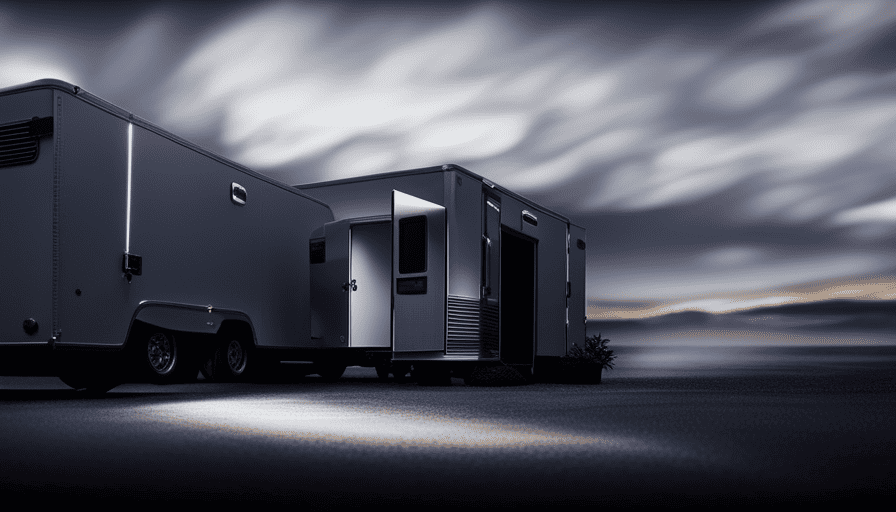
Imagine this: you at last embark on that eagerly anticipated camping trip, only to come back home and discover your cherished camper damp, musty, and moldy. It’s a frightening scenario that no nature lover wants to encounter. However, do not worry, as I am here to offer some helpful advice on preventing moisture from getting into your camper while it is in storage.
Whether you’re storing your camper for the winter or just for a short period of time, moisture can wreak havoc if not properly managed. In this article, I’ll guide you through a series of steps to ensure your camper stays dry and in pristine condition, ready for your next adventure.
From choosing the right storage location to using desiccants, installing ventilation systems, and sealing any leaks or cracks, I’ve got you covered. So let’s dive in and learn how to protect your camper from the damaging effects of moisture.
Key Takeaways
- Choose a well-sealed and insulated storage facility.
- Clean and dry the camper before storage, paying special attention to the bathroom area and holding tanks.
- Use desiccants strategically in areas prone to moisture buildup.
- Regularly check on campers to detect and address potential issues.
Choose a Dry Storage Location
You need to choose a dry storage location to protect your camper and keep moisture out, so you can rest easy knowing it’s safe and sound. Proper moisture control and humidity prevention are essential to ensure that your camper doesn’t suffer any damage while in storage.
Firstly, look for a storage facility that’s well-sealed and insulated. This’ll help keep the humidity levels low and prevent moisture from seeping into your camper.
Additionally, choose a location that isn’t prone to flooding or excessive humidity, as these conditions can lead to mold and mildew growth.
When selecting a storage spot, consider areas that receive good ventilation and sunlight. Adequate airflow will help prevent condensation and reduce the likelihood of moisture buildup. Keep in mind that storing your camper under trees or in damp areas can increase the chances of moisture-related problems.
Lastly, if storing your camper at home, consider using a dehumidifier or moisture-absorbing products like desiccant bags or moisture control crystals. These’ll help eliminate excess moisture and maintain a dry environment inside your camper.
By choosing a dry storage location that prioritizes moisture control and humidity prevention, you can ensure the longevity of your camper.
Now, let’s move on to the next step – cleaning and drying the camper before storage.
Clean and Dry the Camper Before Storage
Before stowing away, make sure your camper is spotless and bone-dry. This is important to prevent moisture from causing damage during storage.
There are a few preventive measures and cleaning techniques that can help keep your camper free of moisture. First, start by removing all dirt, debris, and any leftover food from the interior. Use a vacuum cleaner to thoroughly clean the floors, carpets, and upholstery. Wipe down all surfaces, including countertops, tables, and cabinets, with a mild detergent solution to get rid of any lingering moisture.
Next, pay special attention to the bathroom area. Clean and dry the shower, toilet, and sink, making sure to remove any moisture that could lead to mold or mildew growth. Don’t forget to empty and clean the holding tanks to prevent any unpleasant odors or leaks.
Lastly, open all windows and vents to allow for proper ventilation. This will help circulate air and further dry out the camper. Consider using a dehumidifier or leaving a fan running to speed up the drying process.
By following these cleaning techniques and preventive measures, you can ensure that your camper is moisture-free before storing it.
In the next section, we’ll discuss the use of desiccants and moisture absorbers to provide an additional layer of protection against moisture damage.
Use Desiccants and Moisture Absorbers
To further safeguard your camper from moisture damage, it’s time to utilize desiccants and moisture absorbers. These handy tools are designed to prevent condensation and reduce humidity levels inside your camper, keeping it dry and moisture-free during storage.
Desiccants work by absorbing moisture from the air, while moisture absorbers are specifically designed to trap and collect excess moisture.
When using desiccants, make sure to place them strategically throughout your camper. Focus on areas prone to moisture buildup, such as closets, cabinets, and under the sink. You can find desiccant packets that are easily hung or placed in these areas.
Additionally, consider using moisture absorbers, such as dehumidifier buckets or hanging bags, which can collect and contain excess moisture.
By incorporating desiccants and moisture absorbers into your camper storage routine, you can effectively prevent condensation and reduce humidity levels. This will help protect your camper from mold, mildew, and other moisture-related issues that can cause damage over time.
To further enhance moisture control, consider installing ventilation systems or fans. These will promote air circulation and help keep humidity levels in check.
With the combined use of desiccants, moisture absorbers, and proper ventilation, you can confidently store your camper knowing it’s protected from moisture damage.
Install Ventilation Systems or Fans
Installing ventilation systems or fans in your camper will create a refreshing breeze that will circulate throughout, ensuring a dry and comfortable storage space. Proper airflow is crucial in preventing moisture buildup, which can lead to mold, mildew, and damage to your camper’s interior. There are a few options to consider when it comes to improving ventilation.
One option is to install windows in your camper. Windows allow for natural airflow and can be strategically placed to maximize ventilation. Additionally, using exhaust vents can help remove moisture-laden air from inside the camper. These vents can be installed in the roof or walls, and they work by expelling stale air and drawing in fresh air from outside.
To further enhance ventilation, you can also consider adding fans to your camper. Fans help circulate air and prevent stagnant pockets of moisture. You can opt for ceiling fans or portable fans that you can position strategically to ensure proper airflow.
By installing ventilation systems or fans, you can effectively control moisture levels in your camper during storage. However, it’s important to note that proper ventilation alone may not be enough to keep all moisture out. In the next section, we will discuss how to seal any leaks or cracks to further protect your camper from moisture intrusion.
Seal Any Leaks or Cracks
Make sure you take the time to seal any leaks or cracks in your camper, as this will help maintain a dry and protected interior space that you can confidently store your belongings in. Preventative measures are essential in keeping moisture out of your camper during storage.
Inspect the exterior thoroughly for any signs of leaks or cracks. Pay close attention to seams, windows, doors, and vents, as these areas are prone to damage over time. Use a high-quality sealant specifically designed for campers to repair any leaks or cracks you find. Apply the sealant generously, making sure to cover the entire area and create a watertight seal.
Repairing leaks is crucial because even the smallest cracks can allow moisture to seep into your camper. Once moisture enters, it can cause mold, mildew, and damage to your belongings. By sealing leaks and cracks, you are creating a barrier that prevents moisture from entering the camper, ensuring a dry storage space.
As we move on to the next section about using a dehumidifier, it’s important to remember that sealing any leaks or cracks should be done before considering other moisture prevention methods.
Use a Dehumidifier
Now that we’ve discussed the importance of sealing any leaks or cracks in your camper, let’s move on to another effective method of keeping moisture out: using a dehumidifier. By incorporating a dehumidifier into your storage routine, you can prevent condensation and minimize humidity levels, ultimately safeguarding your camper from moisture damage.
A dehumidifier works by removing excess moisture from the air, helping to maintain a dry environment inside your camper. This is especially important during storage when the camper is closed up for long periods, as stagnant air can lead to increased humidity levels and condensation. By running a dehumidifier, you can effectively combat these issues and ensure that your camper remains dry and free from moisture-related problems.
To help you visualize the benefits of using a dehumidifier, here is a 2-column, 5-row table:
| Before Using a Dehumidifier | After Using a Dehumidifier |
|---|---|
| Dampness and condensation on walls and surfaces | Dry and moisture-free interior |
| Musty odor | Fresh and clean air |
| Mold and mildew growth | Prevention of mold and mildew |
| Damaged upholstery and fabrics | Preserved quality of upholstery and fabrics |
| Risk of structural damage | Increased longevity of the camper |
By utilizing a dehumidifier, you can significantly reduce the risk of moisture-related issues and maintain the overall condition of your camper. In the next section, we will discuss another important step in keeping moisture out of your camper during storage: removing all moisture-prone items.
Remove All Moisture-Prone Items
To ensure your camper stays dry and protected, imagine stepping into a world free from the clutches of moisture, where your belongings are safe and secure. One of the most effective ways to prevent mold and reduce humidity in your camper during storage is by removing all moisture-prone items.
Start by thoroughly cleaning and drying the interior of your camper, ensuring that there are no spills or damp areas left behind. Remove any fabric or upholstered items such as curtains, cushions, and bedding, as these tend to absorb and retain moisture. Additionally, take out any rugs or carpets that can trap moisture underneath. By removing these items, you eliminate potential breeding grounds for mold and reduce the overall humidity levels in your camper.
Remember to also check for any signs of leaks or cracks in your camper’s structure and repair them promptly. Inspect the windows, doors, and roof for any gaps or damages that could allow moisture to seep in. By addressing these issues, you can further prevent moisture from entering your camper during storage.
With all moisture-prone items removed and any necessary repairs made, you can now transition into the subsequent section about using waterproof covers for outdoor storage.
Use Waterproof Covers for Outdoor Storage
Ensure your camper stays dry and protected by using waterproof covers for outdoor storage. Waterproof tarps are an excellent option for keeping moisture out of your camper. These tarps are specifically designed to repel water and prevent any leaks or seepage. They provide a barrier between your camper and the elements, ensuring that rain, snow, and other forms of moisture don’t penetrate the exterior.
When choosing a waterproof tarp, make sure to select one that’s the appropriate size for your camper and securely fasten it to prevent any wind from blowing it off.
In addition to waterproof tarps, you can also use silica gel packets to absorb any excess moisture inside your camper. These small packets contain silica beads that effectively absorb moisture and help maintain a dry environment. Place them strategically inside your camper, focusing on areas prone to moisture buildup such as closets, cabinets, and under mattresses. Silica gel packets are readily available online or at hardware stores.
By using waterproof covers and silica gel packets, you can significantly reduce the risk of moisture damage to your camper while it’s in storage. However, it’s essential to check on the camper regularly to ensure everything’s still in good condition. This’ll allow you to address any potential issues promptly and maintain the overall integrity of your camper.
Check on the Camper Regularly
Regularly checking on your camper is crucial to detecting any potential issues and maintaining its overall condition, such as discovering a small leak before it becomes a major problem. For example, imagine you have stored your camper for a few months and upon checking it, you notice a small puddle of water near the roof, indicating a possible leak that needs immediate attention. By catching this issue early on, you can prevent further water damage and the potential growth of mold inside your camper.
To emphasize the importance of regular maintenance, let’s consider the emotional impact of neglecting to check on your camper. Imagine coming back to your storage facility after a long winter and finding your beloved camper filled with mold, a musty smell permeating the air, and irreversible damage to the interior. This scenario is disheartening and can be easily avoided by simply checking on your camper regularly.
Regular maintenance not only helps to prevent mold and water damage, but it also allows you to address any other issues that may arise, such as loose seals, damaged vents, or cracks in the exterior. By taking the time to inspect your camper periodically, you can ensure that it remains in optimal condition, ready for your next adventure.
Considering climate-controlled storage options is the next step in protecting your camper from moisture and other potential hazards.
Consider Climate-Controlled Storage Options
To prevent moisture from wreaking havoc on your camper while it’s in storage, it’s crucial to take the necessary precautions. In my previous subtopic, I discussed the importance of checking on your camper regularly. Now, let’s dive into an alternative storage option that can provide even better protection: climate-controlled storage.
When it comes to safeguarding your camper against moisture, climate-controlled storage is a game-changer. Unlike regular storage units, climate-controlled facilities maintain a constant temperature and humidity level, creating an optimal environment for preserving your camper. These units are equipped with HVAC systems that regulate temperature and dehumidifiers that keep moisture at bay.
By opting for climate-controlled storage, you significantly reduce the risk of mold and mildew growth. These pesky culprits thrive in damp environments, and without proper ventilation, they can wreak havoc on your camper’s interior. However, in a climate-controlled unit, the controlled humidity levels prevent the growth of mold and mildew, ensuring your camper remains dry and pristine.
Remember, preventing moisture damage is essential for the longevity and value of your camper. So, when considering storage options, don’t overlook the benefits of climate-controlled units. With their ability to maintain a controlled environment and inhibit mold and mildew growth, they provide the ultimate protection for your beloved camper.
Frequently Asked Questions
Can I store my camper in a garage or does it need to be in a specific dry storage location?
You can store your camper in a garage, but it’s important to ensure that the garage storage is dry. Moisture can cause damage to your camper, so it’s essential to choose a location that offers protection from humidity and dampness. Consider using dehumidifiers or moisture-absorbing products to keep the air inside the garage dry. Additionally, proper ventilation is crucial to prevent condensation and mold growth.
Is it necessary to clean the camper before storing it, or can I skip this step?
It is necessary to clean the camper before storing it to prevent any damage or mold growth. Cleaning steps before storage include removing all food and emptying and cleaning the refrigerator. Additionally, wiping down surfaces, vacuuming and mopping the floors, and ensuring all windows and doors are tightly closed are important. If you don’t have time to clean, you can hire a professional cleaning service to do it for you. However, it’s highly recommended to clean the camper yourself for better results.
Are there any specific types of desiccants or moisture absorbers that work best for keeping moisture out of a camper in storage?
When it comes to keeping moisture out of a camper in storage, using the best desiccants and effective moisture absorbers is crucial. These products are designed to remove excess moisture from the air, preventing any potential damage to your camper.
Some popular options include silica gel packets, activated charcoal, and calcium chloride. Silica gel packets are great for small spaces, while activated charcoal and calcium chloride are known for their high moisture-absorbing capabilities.
Utilizing these desiccants will help maintain a dry and mold-free environment for your camper.
Do I need to hire a professional to install a ventilation system or fan in my camper for storage?
You don’t need to hire a professional to install a ventilation system or fan in your camper for storage. There are plenty of DIY methods that can effectively keep moisture at bay.
One option is to use vent covers or vent cushions to allow for air circulation while keeping the elements out. Another option is to use moisture absorbers or desiccants strategically placed throughout the camper. These simple solutions can help prevent moisture build-up and keep your camper dry during storage.
How do I identify and effectively seal leaks or cracks in my camper to prevent moisture from entering during storage?
Identifying leaks in your camper is crucial to prevent moisture from entering during storage. Start by inspecting the exterior for any cracks, gaps, or damaged seals. Pay close attention to windows, doors, and roof seams.
Once identified, use effective sealing techniques such as silicone sealants or weatherstripping to seal these areas. It’s important to thoroughly clean and dry the surfaces before applying any sealant.
Regularly inspect and maintain these seals to ensure your camper remains moisture-free in storage.
What Steps Should I Take to Dewinterize My Camper and Prevent Moisture Build-up in Storage?
Dewinterizing your camper requires specific steps to prevent moisture build-up in storage. First, drain and flush the antifreeze from the water system. Then, check for any leaks or damages. Reinstall water filters and water heaters, ensuring proper connections. Run water through all taps to purge any remaining antifreeze. Lastly, clean and dry the camper thoroughly before storing it to keep moisture at bay.
Conclusion
To keep moisture out of your camper in storage, it’s important to take the necessary precautions. Choose a dry storage location and make sure your camper is clean and dry before storing it. Use desiccants and moisture absorbers to keep the air inside dry. Install ventilation systems or fans to circulate air and prevent moisture buildup. Seal any leaks or cracks to keep water out. Remove all moisture-prone items and use waterproof covers for outdoor storage. Regularly check on your camper and consider climate-controlled storage options to ensure its protection. Remember, "a stitch in time saves nine," so taking these steps now will save you from potential costly repairs in the future.
Jason is the author of Laienhaft, a blog for all things outdoor and camping. If you’re looking for the best tent to take on your next camping trip, or need some advice on how to get started with recreational camping, Jason has you covered. He’s also an expert on survival skills – if you’re ever lost in the wilderness, he’s the guy you want to find!
-

 Beginners Guides2 months ago
Beginners Guides2 months agoLaienhaft Acquires aircooled-tv.com Domain to Add Focus on Aircooled Campervans
-

 Backpacker2 months ago
Backpacker2 months agoLaienhaft Acquires Infos-Campings.Com Domain – Our Joined Way Forward to Experience Outdoor, Camping, and Making Friends and Live the Experience
-
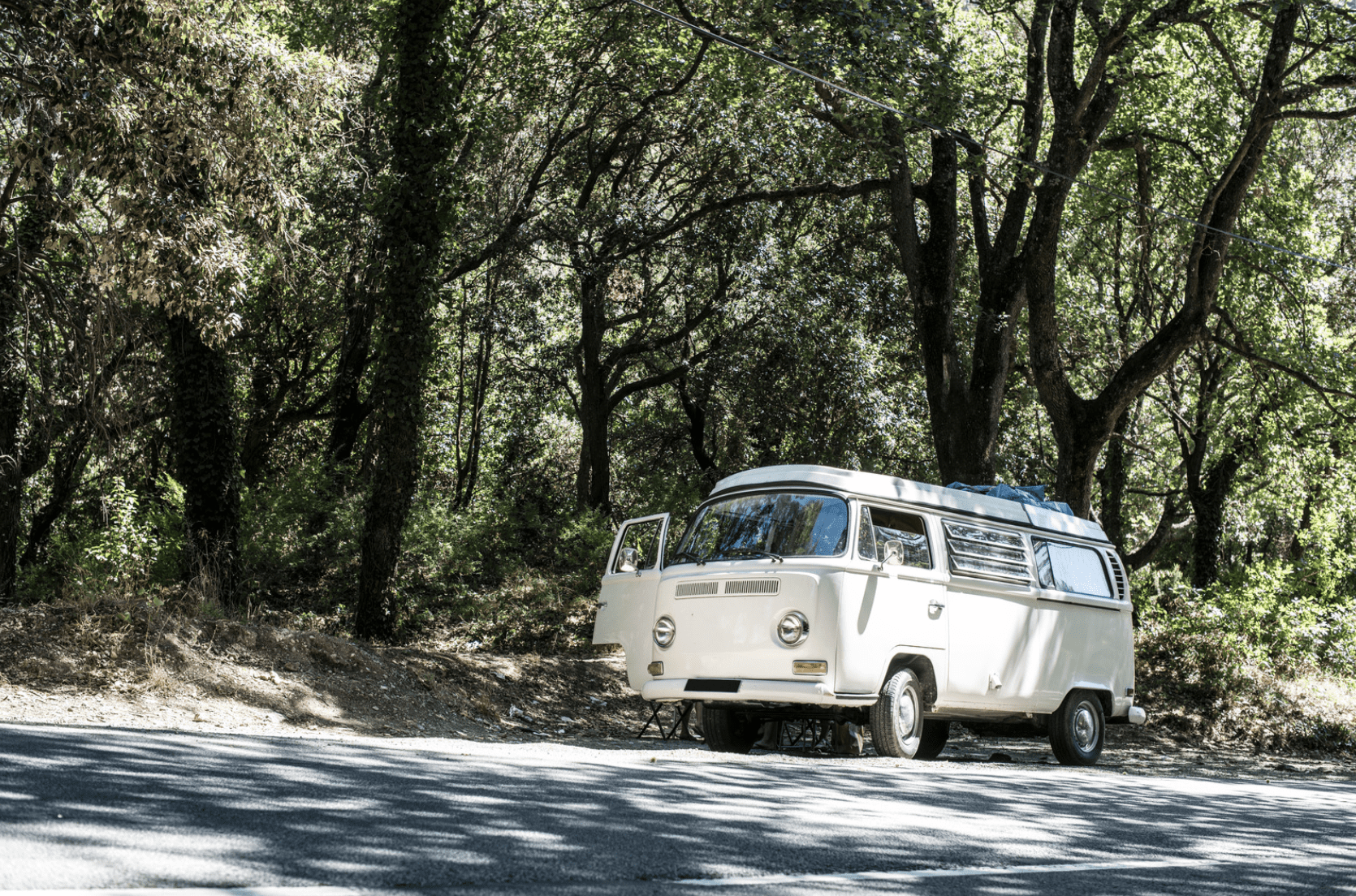
 Beginners Guides2 months ago
Beginners Guides2 months agoThe Guide to the Best Camping License Plate Ideas for Cars and RVs
-
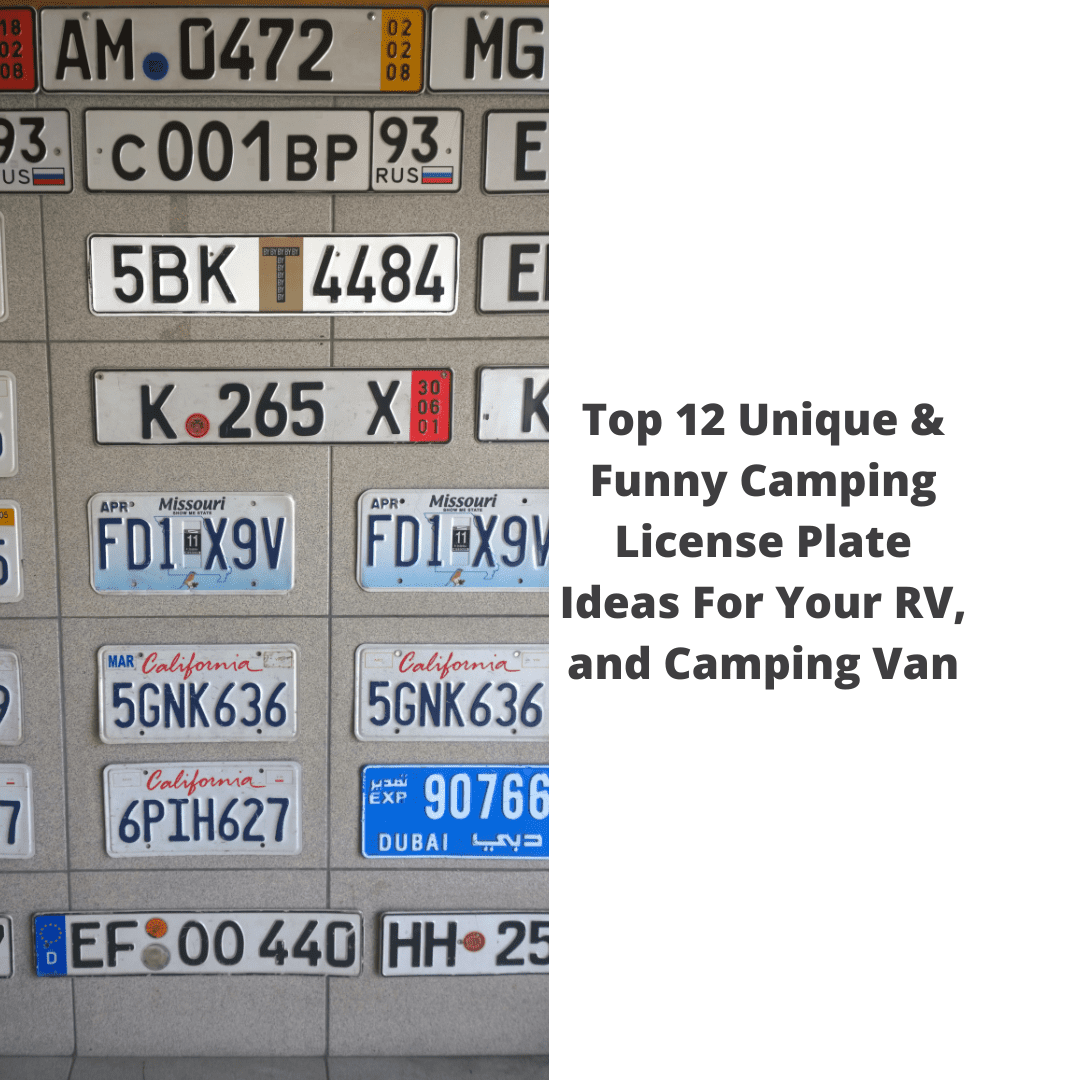
 License Plate2 months ago
License Plate2 months agoTop 12 Unique & Funny Camping License Plate Ideas For Your RV, and Camping Van
-
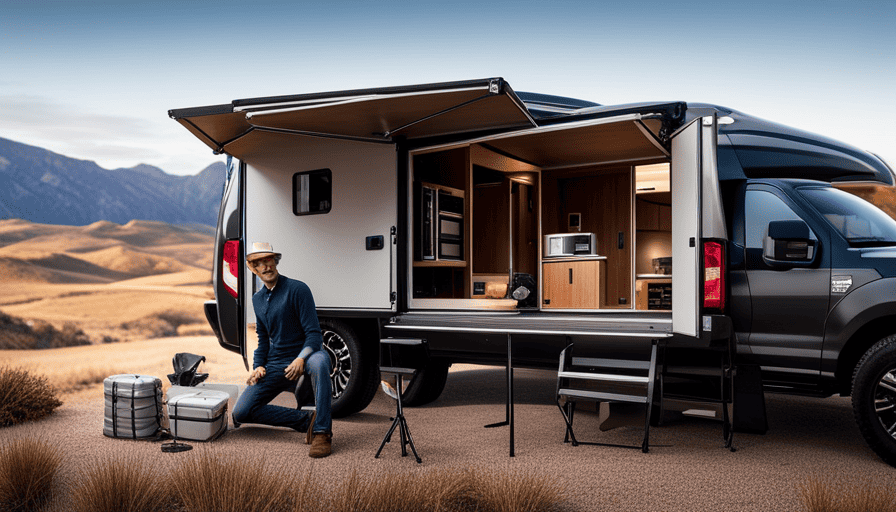
 Beginners Guides2 days ago
Beginners Guides2 days agoHow To Build A Slide In Truck Camper
-

 Beginners Guides1 month ago
Beginners Guides1 month agoHow To Install A Camper Shell
-

 Beginners Guides2 months ago
Beginners Guides2 months agoWhy Does My Throat Hurt After Camping? The Most Common Reasons and How to Fix Them
-
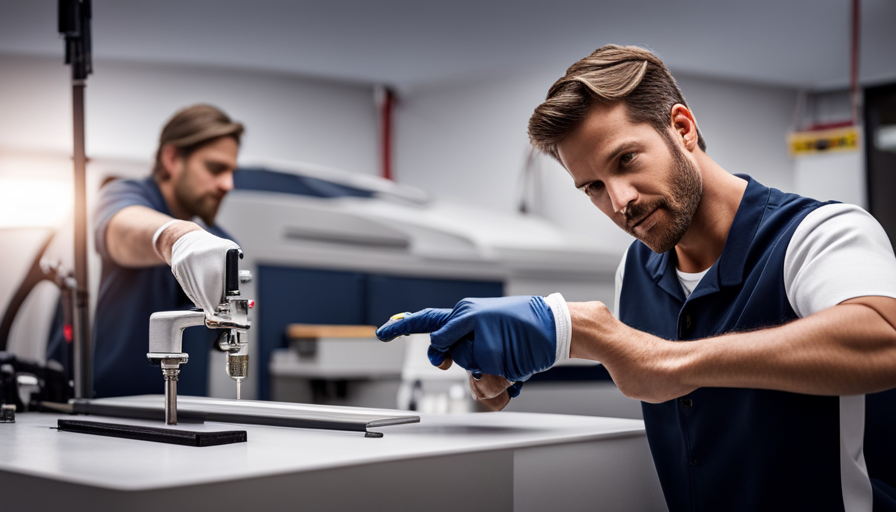
 Beginners Guides1 month ago
Beginners Guides1 month agoHow To Lubricate Pop Up Camper Lift System



